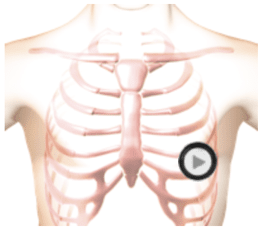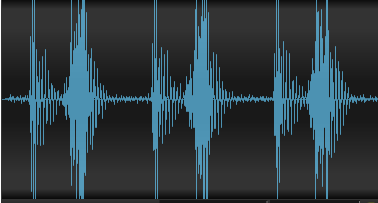Second Heart Sound and Late Systolic Click
Certain heart sound configurations mimic a split second heart sound. One of these conditions is a late systolic click plus a single second heart sound (S2). Since the late systolic click occurs just before the S2, it is easy to confuse the two with a split S2. Listen carefully to the two sounds. If the first of the pair is of higher frequency and shorter duration than the second, it is a late systolic click followed by a single second heart sound. Another way of distinguishing a late systolic click from a split S2 is to move the stethoscope head to the pulmonic area. The late systolic click will disappear, and you will only hear the single S2. A late systolic click is caused by degeneration of the mitral valve leaflets. This degeneration causes the closing of the leaflets to make a "clicking" sound during late systole. On the anatomy video you will see prolapse of the anterior lateral mitral valve leaflet which is the cause of the late systolic click.Auscultation Sounds


Patient Recording of Second Heart Sound and Late Systolic Click


Patient Recording - Half Speed


Position

The patient's position should be supine.
Listening Tips for Second Heart Sound and Late Systolic Click
Systole:higher-pitched click late in systole with short durationWaveform (Phonocardiogram)
Observe Cardiac Animation for Second Heart Sound and Late Systolic Click
Authors and Sources
Authors and Reviewers
- EKG heart rhythm modules: Thomas O'Brien.
- EKG monitor simulation developer: Steve Collmann
-
12 Lead Course: Dr. Michael Mazzini, MD.
- Spanish language EKG: Breena R. Taira, MD, MPH
- Medical review: Dr. Jonathan Keroes, MD
-
Heart sounds and mentorship: W. Proctor Harvey, MD
- Medical review: Dr. Pedro Azevedo, MD, Cardiology
-
Last Update: 1/8/2023
Sources
-
Electrocardiography for Healthcare Professionals, 5th Edition
Kathryn Booth and Thomas O'Brien
ISBN10: 1260064778, ISBN13: 9781260064773
McGraw Hill, 2019 -
Rapid Interpretation of EKG's, Sixth Edition
Dale Dublin
Cover Publishing Company -
12 Lead EKG for Nurses: Simple Steps to Interpret Rhythms, Arrhythmias, Blocks, Hypertrophy, Infarcts, & Cardiac Drugs
Aaron Reed
Create Space Independent Publishing -
Heart Sounds and Murmurs: A Practical Guide with Audio CD-ROM 3rd Edition
Elsevier-Health Sciences Division
Barbara A. Erickson, PhD, RN, CCRN - Clinical Heart Disease
W Proctor Harvey, MD
Clinical Heart Disease
Laennec Publishing; 1st edition (January 1, 2009) -
The Virtual Cardiac Patient: A Multimedia Guide to Heart Sounds, Murmurs, EKG
Jonathan Keroes, David Lieberman
Publisher: Lippincott Williams & Wilkin)
ISBN-10: 0781784425; ISBN-13: 978-0781784429 - Project Semilla, UCLA Emergency Medicine, EKG Training Breena R. Taira, MD, MPH
Second Heart Sound and Late Systolic Click | #49